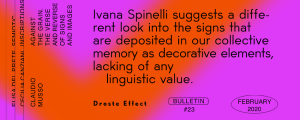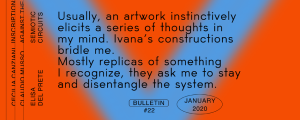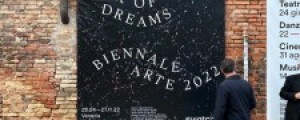Wade Guyton: A draft review
In his last solo exhibition SIAMO ARRIVATI (“WE’VE ARRIVED”), conceived for the MADRE Museum in Naples (Italy) and curated by Andrea Viliani, the American artist Wade Guyton (Hammond, Indiana, 1972) explored the state of the production and circulation of digital images nowadays. Guyton has been invited to stay in residence and work for a short period in the southern Italian city of Naples, where the artist dedicated his research to the potential forms that images may assimilate through reconstructing the sensibility and the original language that images may assume, starting from the way they are globally shared. For his solo show on the upper floor of the MADRE, which opened May 2017, Guyton approaches a simulation of an industrial printing workshop through multiplying elements: fifty paintings and a number of installations.

01_Untitled 2017 Epson UltraChrome HDX inkjet printing on linen © Wade Guyton
Courtesy the artist and Fondazione Donnaregina per le arti contemporanee, Napoli
Foto © Ron Amstut
For over two decades now, the artist has been questioning the meaning of images and the inherited understanding of its transformation process. Guyton’s printed canvases externalize how the artist is inclined not only to employ digital media as a discrete set of tools facilitating his work, but also illustrates his readiness to update the expressive and cognitive canons of the medium itself. From a technical point of view, the artist usually uses an inkjet printer to apply images to canvas which are pre-processed and modified by digital editing programs. The act of the picture-making is enriched by a dynamic relationship created by unexpected and unpredictable mechanical errors and discrepancies which occur during the printing phase. Furthermore, Guyton manipulates the inkjet printer (taking it to its mechanical limits). He challenges the specific function of the machine and through the deformation of its normal functionality, he probes its conceptual implications. The consequences of this kind of work are enumerable, but important here is his engagement with context as a fluid digital and cultural domain.

SIAMO ARRIVATI Exhibition view, Madre · Museo d’arte contemporanea Donnaregina, Napoli, 2017 © Wade Guyton Courtesy the artist and Fondazione Donnaregina per le arti contemporanee, Napoli Foto © Ron Amstutz
The American artist seems to be aware that there is a way to reveal the contingency of digital technology by showing modes of potential digital output. This conflict between digital images and analogue printing leads us to consider the question of the universality of the digital imagery (VE being the best). In Naples, Guyton and his team developed the works in situ within the rooms of the museum. The composition of his large paintings, which have been influenced strongly by physical spaces in the past, demarcated by e.g. the limits of the printing machine, the surface of his studio’s floor, or more trivially to the size of his elevator in his New York studio, indicate that Guyton has been highly affected by the institutional environment(s) where he has worked. The artist’s treatment of the exhibition space follows this pattern and is further strengthened in MADRE, making this show a significant moment for his public production. Ostensibly stimulated or even forced to do so by the specific character of the Neapolitan environment, the artist evidently has constructed an artistic narration that deals with the inside and outside of the museum.
What is gathered in the pictures exhibited is a kind of controversial digital authenticity, a kind of analogue transposition of digital reproductions linked transitively to the cultural codes of the city. It reflects the very particular condition of the city of Naples, and it recreates a very questionable and absurd “local” internet. The artist subscribed for a personal membership with Il Mattino, a local newspaper, thereby making use of headlines and advertisements appearing on its homepage in order to reproduce them in the form of paintings. As I have mentioned before, this exhibition is bent within the context of Naples and provides a speculative backdrop to the Neapolitan society today. Focusing on a time when a new typology of image user experiments with “the image”, such that each of Guyton’s Neapolitan works is supposed to be hung on the social background. For example, the homepage content he reproduces on canvas of the newspaper Il Mattino associates the corporate identities of advertisements of companies like Amazon, Euronics, and McDonald’s with the co-habitation of the daily news of the seismic activities in the Campi Flegrei. In this printed painting, Guyton referred to the practice of another iconic American artist, Andy Warhol. So too, Guyton may perceive the trends of digital languages as evidenced by his play with the tiny logic of a post-ideological society. Particularly, Guyton seems to be mentioning the well-known triptych Fate Presto in which Warhol reproduced the page of the same newspaper of 26 November 1980 – the occasion of the terrible earthquake that hit Naples at that time – a moment of economic unrest.

10_Untitled 2017 Epson UltraChrome HDX inkjet printing on linen © Wade Guyton
Courtesy the artist and Fondazione Donnaregina per le arti contemporanee, Napoli
Foto © Ron Amstutz
Zooming out, the investigation the artist has undertaken in the contemporary (time-based) context gathers the city of Naples through panoramas of the museum, blurred portraits of the narrow streets, snapshots of the city center, and images of seafood displayed in markets, producing a mix which recalls the random sampling that is characteristic of the ordinary touristic images shared on the Internet. Yet, Guyton re-mixes a complex conceptual system of living-image production native to the city. This tiny reflection can be a starting point for a consideration on how we perceive and think about local reality in a post-Internet society. The way the artist aims to portray this ongoing process – the localization of the global, and the globalization of the local – makes his show at MADRE relatively critical.
Guyton’s paintings are in conjunction with the very particular moment of change that the city of Naples is experiencing, yet their felt presence at MADRE brought me to reflect on how, sometimes, the well-established artists are detached from everyday life, despite their conceptual appreciation of its spectrum. Guyton attempted to ensure that his behavior followed the local code of conduct, but it appears to be true that his position is predominant. The images, quotations, appropriations obtained by the American artist hide amongst the fabric of a reality that is not touchable in such a short time, posing a question to the status quo of hypermobility of international art makers via institutional residencies.

26_Untitled 2017 Epson UltraChrome HDX inkjet printing on linen © Wade Guyton
Courtesy the artist and Fondazione Donnaregina per le arti contemporanee, Napoli
Foto © Ron Amstutz
Guyton’s work as placed in the museum generates recursive power and seems to be aware of its role. However intuitively, Naples’ soul and its proverbial energy look exploited, even frustrated by Guyton’s action of mechanical reproduction. The site-specific, the wish to place the city at the heart of Guyton’s project, produce the opposite effect: the generation of empty images placed in a silent space out of context. Walking along the exhibition and deconstructing the issues connected with the medium of painting, it appears to be evident that Wade Guyton stands in continuity with traditional and established ideas of the male-white and American painter – able to innovate the flat, impoverished contemporary painting. The hyped New York painter makes no attempt to debunk his own authorship here on the basis of social considerations. Guyton uses technology and an inkjet printer to make paintings that on the one hand allude to his notable artist predecessors, and on the other hand are the result of a process that brings the painting to its last unavoidable stage: mechanical production, which stands beyond every human capability. We have here a kind of stereotype that is perceptible in his work, and that may represent an important complicating factor of reflection, as well as an assessment for this Neapolitan exhibition, where Wade Guyton clearly appears as what he is: a leading American artist. SIAMO ARRIVATI is an exhibition that, instead of marking the arrival of something new, confirms the constant agentive presence of a person already present in the art scene.
SIAMO ARRIVATI, curated by Andrea Viliani at MADRE Museum, Naples through September 11, 2017
by Vincenzo Estremo
in Focus on Europe
Aug 28, 2017






















